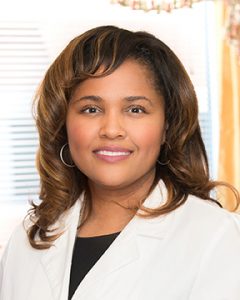By Ameera Steward
For The Birmingham Times
Many do not know that July is Fibroid Awareness Month, and even fewer know much about fibroids at all—and that includes many women.
Uterine fibroids create challenges for millions of women across the globe, and Fibroid Awareness Month is intended raise awareness about this very common but seldom discussed condition. With the month coming to an end, The Birmingham Times reached out to some area medical experts to discuss fibroids and the impact they have on women’s health.
According to the U.S. Department of Health and Human Services Office on Women’s Health (OWH), “Fibroids are muscular tumors that grow in the wall of the uterus (womb).
Another medical term for fibroids is leiomyoma or just ‘myoma.’ Fibroids are almost always benign (not cancerous). Fibroids can grow as a single tumor, or there can be many of them in the uterus. They can be as small as an apple seed or as big as a grapefruit. In unusual cases they can become very large.”
Women of childbearing age, meaning someone who has started their menstrual cycle, can be at risk for fibroids; they’re more common in women ages 30 and up, but can start at any age. Up to 80 percent of women have them—seven out of 10 white women, and eight out of 10 African American women, though the reason behind fibroids being more prominent among Black women is still unknown, according to area medical experts.
Visit Your Doc
If you’re experiencing fibroid-like symptoms or unsure of what you’re dealing with, you can start with your primary care provider.
“The biggest thing we see in primary care is people who come in with period problems, severe problems with heavy bleeding, and also bad cramping,” said Ebonee Lyons, DNP,, a family nurse practitioner and owner of Lyons Health and Wellness. “Sometimes it’s not necessarily just period problems, but many people have dealt with the problems for so long that they’re not really aware that [the symptoms they are experiencing are] abnormal.”
Fibroids are diagnosed with a series of exams. The type of exam depends on the severity of the symptoms.
“We can see usually how many [fibroids] are there and what size they are,” Lyons explained. “We can measure them and then make recommendations from there that are tailored to that individual’s presentation of whether they are causing problems are not.”
Even though a primary care physician can diagnose fibroids, it’s also good to consult with a gynecologist, “a doctor who specializes in female reproductive health; they diagnose and treat issues related to the female reproductive tract, [including] the uterus, fallopian tubes, ovaries, and breasts,” according to Web MD.

“If a woman has fibroids and is not experiencing any symptoms, she doesn’t technically have to do anything to treat them,” said Tomeka Roberts, M.D., a gynecologist at Ascension St. Vincent’s Birmingham.
“But if you have symptoms from them, … you’re bleeding heavy and you are anemic, [for instance], then we would want to consider some intervention,” she said.
Roberts added that the typical first line of intervention is birth control because the hormones in birth control pills may help control some of the symptoms.
“For many people, the presence of fibroids can increase the menstrual flow and cause painful cramps. Birth control pills, on the other hand, are known to reduce both,” according to USA Fibroid Centers.
Roberts explained that a low-dose birth control pill is usually given initially, and the dosage can be increased as needed.
“It’s dependent on if it’s worth taking the medicine to control the bleeding,” said Roberts. “You have to talk with your doctor to find out which one would be best to help control any bleeding issues you have.”
Lyons added that if the fibroids are small and not causing any issues, she still recommends ongoing follow-ups to monitor the tumors.
Roberts added, “I tell people to be aware of their bodies and get regular checkups because they can make decisions early if things are caught early. They’ll be aware of their options before it gets to a point where we don’t have many options.”
According to USA Fibroid Centers, “There are different tyles of fibroids, … [and they] are generally classified by location and can vary in size and number. Although not everyone experiences fibroid symptoms, the location, size, and number of fibroids involved tend to impact their severity.”

Consider Lifestyle Changes
In addition to regular wellness checks, you also can consider holistic approaches, especially if you don’t want to start off with medications.
Osunde Ajala, founder of the Yoni Steam Institute in Ensley, Alabama, not only helps women shrink and heal their fibroids through yoni steaming, or steaming the vaginal area with herbs, but also helped herself through the practice.
“I started the Yoni Steam Institute because I had dealt with fibroids,” she said. “I started using vaginal steaming as a method to assist me with the symptoms I was having. After I did a steam one time, … the first time, I never had anymore heavy bleeding, [so] I constantly kept up with my steaming process.”
When choosing the herbs to use for both the yoni steam and to ingest, Ajala looks at those types that may shrink the fibroids, help with heavy bleeding, and reduce pain. Among the herbs Ajala recommended are chasteberry, turmeric, ginger, red raspberry, red clover, and pau d’arco. She also suggested dietary changes; for instance, she added more leafy greens, fruits, legumes, and oats to her diet and cut back on her soy consumption.
Ajala also noted that people may want to stay away from foods that can contribute to weight gain and fibroid growth, such as red meat, diary, and processed sugars.
In addition, Ajala stressed the importance of heat therapies for overall womb health.
“Adding heat to your womb is very helpful with reducing inflammation and relaxing the level of stress you may have in your life, as well,” she said. “Heat therapies, [such as placing a heating pad or hot water bottle in the area] or even just going to a sauna or a steam room, can be helpful. … Having heat directed to the womb gets into those fatty tissues and helps to relieve that abnormal cell growth that’s happening in the womb.”
As a yoni steam practitioner, Ajala focuses on mind, body, and spirit, too. So, when it comes to fibroids, she emphasizes the importance of affirmations and yoga, as well other practices she’s mentioned.
Lyons agreed, stating that fibroids affect women both physically and mentally.
“It creates a mental impact because patients who have heavy bleeding and bad periods try to change their lifestyle around that time of the month. It limits their activities and what they can do. … Maybe the are some healthy habits they usually love to do, but they have to put a pause on things; they can’t do those workouts or can’t be as fully present as they would like in their life because of the health condition,” she said, adding that fibroid symptoms can even affect a woman’s ability to function at work.
Lyons encourages women to not only see a physician regularly but also practice adequate self-care and reduce stress to improve overall health and wellness.
“Stay proactive with your health and go to the doctor before things get too bad,” she said.
Know Your Options
In many instances, women dealing with fibroids are told they need a hysterectomy. This procedure, according to the OWH, is “a surgery to remove a woman’s uterus. … During the surgery the whole uterus is usually removed. [The] doctor may also remove [the] fallopian tubes and ovaries. After a hysterectomy, [a woman can] no longer have menstrual periods and cannot become pregnant.”
Ajala, Lyons, and Roberts believe a hysterectomy should be used only if absolutely needed and if the patient has tried other options.
“A lot of places say, ‘Oh, your uterus is too big. There’s nothing we can do about it. You need a hysterectomy.’ If anybody ever tells you that and that is not your wish, you need to get a second opinion because we do have so many other options. … It’s a matter of what kind of goal the [patient] has,” Roberts said.
Ajala added, “I feel like they’re overly used, and I feel like we have a lot of options before hysterectomy comes up as something that’s needed. There are other things you can do before it gets to that stage.”
Overall, Ajala, Lyons, and Roberts emphasize the importance of being fully educated about and aware of all options in regard to fibroids.
“I think we need more education, more attention being drawn to it. If I could compare other conditions, I think there is a lot more focus on other things, like different types of cancer,” said Lyons. “I think that bringing more attention to fibroids [through efforts like Fibroid Awareness Month] … will help put it in the forefront of people’s minds.”
Ajala said, “Whatever age [women] come into their cycles is a good time for them to start getting in tuned with their wombs, starting to know what’s normal for their bodies.”
Roberts said, “Women are becoming more aware of their bodies, getting more educated about their bodies,” and Fibroid Awareness Month is a good place to start.”
Understand the Different Types of Fibroids
July is Fibroid Awareness Month, a time to raise awareness about uterine fibroids, a very common but seldom discussed condition that poses challenges for millions of women across the globe. According to USA Fibroid Centers, “… there are several different types [of] fibroids, [which] are generally classified by location and can vary in size and number. Although not everyone experiences fibroid symptoms, the location, size, and number of fibroids involved tend to impact their severity. Medical imaging tools, [such as ultrasounds and MRIs], can provide detailed information about your fibroids as well as guide you toward the best treatment decision that fits your individual needs. For expert care, we recommend consulting a fibroid specialist to explore your [treatment] options.”
Here is a brief overview of the different types of fibroids, as described on the USA Fibroid Centers website:
Intramural fibroids grow within the uterine walls. Common symptoms can include heavy periods lasting 10 days or more, bleeding between periods, pelvic pain, lower-back pain. Symptoms, when present, tend to be mild.
Subserosal fibroids develop outside of the uterus and bulge into the pelvic or abdominal cavity. Common symptoms can include a feeling of heaviness or fullness, frequent urination, constipation or bloating, and abdominal pain or cramping. Symptoms tend to involve fewer uterine issues; instead, the bladder and bowel may be affected.
Submucosal fibroids grow within the innermost lining of the uterus, known as the endometrium. Common symptoms can include very heavy and prolonged menstruation between or during periods; anemia, which can sometimes be severe; pelvic or lower-back pain; passing of frequent or large blood clots; and fatigue and dizziness.
Pedunculated fibroids are attached to the uterine wall by a stalk, or a peduncle. Common symptoms can vary based on location because they can be located within or outside the uterus.
Calcified fibroids can be located either within or outside the uterus; they can develop when a fibroid outgrows its blood supply and undergoes degeneration. Common symptoms can include frequent urination, constipation, and abdominal pain or pressure.
Updated on 7/29/2021 to correct degree for Dr. Lyons.





